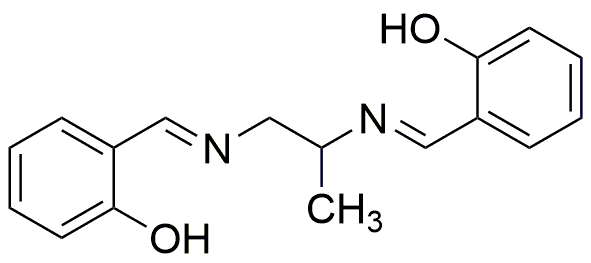N,N'-Bis(salicylidene)-1,2-propanediamine is widely utilized in research focused on:
- Catalysis: This compound serves as an effective ligand in various catalytic processes, particularly in asymmetric synthesis, enhancing reaction selectivity and efficiency.
- Coordination Chemistry: It forms stable complexes with transition metals, making it valuable in the development of new materials and in the study of metal-ligand interactions.
- Biomedical Applications: Its chelating properties allow it to be explored for drug delivery systems, potentially improving the bioavailability of therapeutic agents.
- Analytical Chemistry: Used as a reagent in spectroscopic techniques, it aids in the detection and quantification of metal ions in various samples.
- Research in Material Science: The compound is investigated for its role in creating novel polymers and composites, contributing to advancements in nanotechnology and materials engineering.
General Information
Properties
Safety and Regulations
Applications
N,N'-Bis(salicylidene)-1,2-propanediamine is widely utilized in research focused on:
- Catalysis: This compound serves as an effective ligand in various catalytic processes, particularly in asymmetric synthesis, enhancing reaction selectivity and efficiency.
- Coordination Chemistry: It forms stable complexes with transition metals, making it valuable in the development of new materials and in the study of metal-ligand interactions.
- Biomedical Applications: Its chelating properties allow it to be explored for drug delivery systems, potentially improving the bioavailability of therapeutic agents.
- Analytical Chemistry: Used as a reagent in spectroscopic techniques, it aids in the detection and quantification of metal ions in various samples.
- Research in Material Science: The compound is investigated for its role in creating novel polymers and composites, contributing to advancements in nanotechnology and materials engineering.
Documents
Safety Data Sheets (SDS)
The SDS provides comprehensive safety information on handling, storage, and disposal of the product.
Product Specification (PS)
The PS provides a comprehensive breakdown of the product’s properties, including chemical composition, physical state, purity, and storage requirements. It also details acceptable quality ranges and the product's intended applications.
Certificates of Analysis (COA)
Search for Certificates of Analysis (COA) by entering the products Lot Number. Lot and Batch Numbers can be found on a product’s label following the words ‘Lot’ or ‘Batch’.
*Catalog Number
*Lot Number
Certificates Of Origin (COO)
This COO confirms the country where the product was manufactured, and also details the materials and components used in it and whether it is derived from natural, synthetic, or other specific sources. This certificate may be required for customs, trade, and regulatory compliance.
*Catalog Number
*Lot Number
Safety Data Sheets (SDS)
The SDS provides comprehensive safety information on handling, storage, and disposal of the product.
DownloadProduct Specification (PS)
The PS provides a comprehensive breakdown of the product’s properties, including chemical composition, physical state, purity, and storage requirements. It also details acceptable quality ranges and the product's intended applications.
DownloadCertificates of Analysis (COA)
Search for Certificates of Analysis (COA) by entering the products Lot Number. Lot and Batch Numbers can be found on a product’s label following the words ‘Lot’ or ‘Batch’.
*Catalog Number
*Lot Number
Certificates Of Origin (COO)
This COO confirms the country where the product was manufactured, and also details the materials and components used in it and whether it is derived from natural, synthetic, or other specific sources. This certificate may be required for customs, trade, and regulatory compliance.


